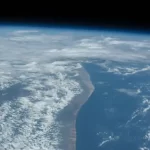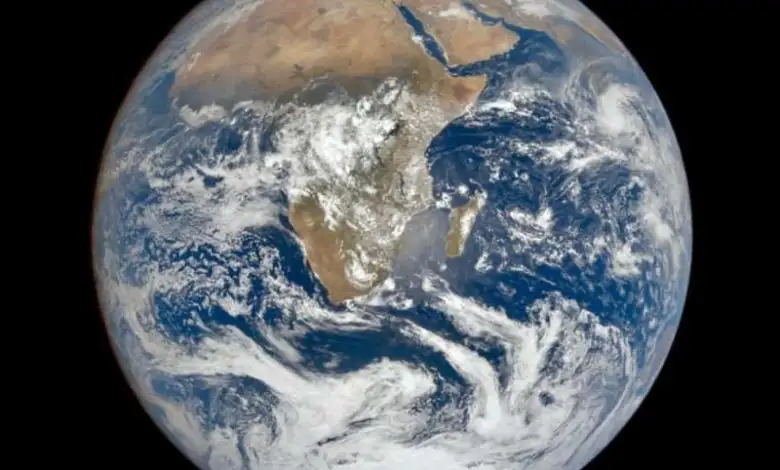In December 1972, NASA’s last Apollo mission (Apollo 17) captured the iconic “blue marble” image of the entire Earth.
Many, including science fiction writer Arthur C. Clarke, predicted that the view of Earth from afar would instill the belief that humanity’s future lay in space. Instead, it made Earth look more distinct, and it has since become a symbol of the global environmental movement.
But that image is now a historical artifact. Fifty years later, on December 8, 2022, NASA took a new image of Earth from its Deep Space Climate Observatory approximately 1.5 million kilometers away. The image reveals visible changes on Earth, some of which are indicative of 50 years of climate change.
Spark Environment
The first pictures of Earth taken from space were momentous historical events. In 1966, the robotic Lunar Orbiter 1 (the first American spacecraft to orbit the moon) sent back some early images including a black and white photo of the partially shaded Earth. The following year, it took A satellite called ATS-3 took the first color image of the Earth.
Then, in 1968, the Apollo 8 crew became the first humans to see and photograph Earth from space. They took various photos through the capsule’s windows, including the famous photo known as “Earthrise.”
This image energized the environmental movement and helped launch the first Earth Day in 1970. Earth Day is held on April 22 each year and now involves more than a billion people worldwide in activities supporting environmental protection.
In 1972, NASA – realizing the general value of Earth photographs – decided to take a picture of the entire Earth as Apollo 17 moved away from Earth’s orbit. The image, illuminated by the sun, was taken at a distance of 33,000 km, and included the first view of Antarctica from space.
global justice
Centered on Africa rather than Europe or America, the image became a photographic statement of global justice
.
Earth also provided the only visible color in space. Dominated by blue light, water and clouds, it seemed a unique environment that showed no signs of human activity.
Cell biologist Lewis Thomas wrote in 1973: “We live inside a blue chamber, a bubble of air that we blow ourselves out.”
This was also the decade in which climatologist James Lovelock put forward Gaia’s theory of the Earth as a self-organizing collection of living and non-living systems. “Earth systems science,” as it is now known, unifies the scientific understanding of the planet, its biosphere, and its changing climate.
The impact of climate change
In December 2022, NASA’s new Blue Marble image was compared to the original image at the University of Portsmouth’s “Whole Earth: Blue Marble in 50” conference. Since 1972, the planet has visibly changed.
The size of the Antarctic ice sheet has clearly shrunk, although the main losses in the Larsen Ice Shelves on the Antarctic Peninsula are not visible in this particular image. It is also difficult to distinguish between the permanent ice sheet and seasonal sea ice. When the new image was taken, it was ice Al-Bahri is still in decline from the previous winter.
While it may be difficult to distinguish between snow and clouds in the satellite imagery, in the original image, some snow appears to be visible in the Zagros and central mountain ranges of Iran (northern Persian Gulf).
This snow completely disappeared in the new picture. This is again within the range of seasonal variation, and research has failed to identify any significant long-term trend in seasonal snow cover in Iran between 1987 and 2007.
Even more surprising is the decline in dark green vegetation in the African tropics, particularly in its northern extension, the dark shade of Lake Chad in the north of the Sahara has diminished, and forest vegetation is now starting hundreds of miles south.
This is consistent with evidence of desertification in the Sahel region of North Africa. Research found that tree density in the West Sahel decreased by 18% between 1954 and 2002.
The Food and Agriculture Organization of the United Nations estimates that between 1990 and 2010, Africa lost 3-4 million hectares of forest annually, a large proportion in the Sahel region.
The inversion of the landscape in Madagascar
Madagascar’s once green landscape is now mainly brown. The country has long been known for its ecological richness, and has now been designated a “biodiversity hotspot,” a term given to an area with significant levels of biodiversity threatened by habitat loss. rapid.
Several species found exclusively in Madagascar, including the Malagasy giant jumping rat, are now at risk of extinction. Their populations declined by 88% between 2007 and 2019.
The original Blue Marble image symbolizes a historical turning point, from belief in unlimited progress to understanding the limitations of the planet’s environment.
Most satellite technology is now focused on serving and understanding Earth, and space exploration has fully confirmed what a unique planet we live on.
Former Star Trek actor William Shatner felt this power during his short trip to space in 2021. Upon his return, he said, “I discovered that beauty is not there, it is here with us all,” adding that evidence of 50 years of environmental degradation is before our eyes, the space mission What really matters now is the mission of saving the Earth.”












